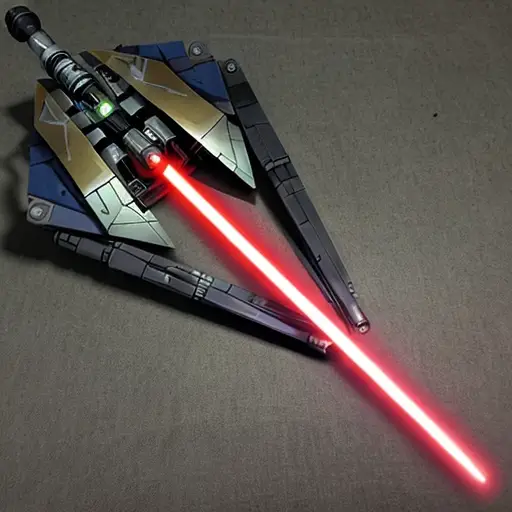Lightsaber Color, Star Wars Character Introduction
What are the lightsaber forms?
What are lightsaber forms and what do they do?
Lightsaber forms are the different physical movements and postures used in lightsaber combat, which determine the behavior of a lightsaber when swung, and are essential for becoming a skilled lightsaber duelist; there are many different forms, each with its own purpose, ranging from offensive to defensive, which can be wielded with one hand, two hands, or even in a dual-wielding style, and skilled users can combine different forms to create new combos and unleash devastating attacks on their opponents, making the mastery of various lightsaber forms a key component in the training of a Jedi or Sith, including the traditional form used by Luke Skywalker and Darth Vader, the defensive Form III, and the aggressive Form II, among others.
Weapon Forms: A guide to the different types of lightsaber forms.
Lightsaber forms are the foundation of lightsaber combat. They teach students how to wield a lightsaber and what techniques should be used against different types of opponents. The Jedi Code says that there is no “right” way to use a lightsaber—any style can be effective in battle if done correctly. This guide will explore each of the seven known forms in detail so that you can decide which one works best for your own fighting style!
Shii-Cho:Shii-Cho is the most basic form of lightsaber fighting developed by Jedi masters. It is the first form of lightsaber fighting that every Jedi apprentice learns when learning fighting skills. Its advantages lie in simplicity and versatility, and it is more suitable for It is used to fight against multiple enemies, and it is easier to expose its shortcomings when facing a single powerful opponent, such as fighting Darth Sidi. So Shii-Cho is more suitable for defense.
Makashi:The fighting style of Makashi, which was the first to use lightsabers against one another and was developed from the basics of Shii-Cho, is believed to have originated as a means of combat developed by the ancient Dark Jedi and Sith to confront the Jedi Knights. Makashi is characterized by its elegance, simplicity, and devastating power. Its attacks and defenses require minimal physical exertion. One-handed swords are often utilized to increase speed and extend the range of motion. Unlike other styles of combat that rely on slashing and blocking, Makashi employs subtle moves such as dodging, stabbing, and cutting, in order to counteract the attack methods of Shii-Cho, which focus on destroying an opponent’s fighting ability.
Soresu:Soresu originated from the use of lightsabers by the Jedi to defend against blasters. When facing multiple opponents, it became apparent that lightsabers could be used to deflect the enemy’s attacks. This style of combat eventually evolved into a defensive technique, focusing on reducing the chances of being attacked. Soresu emphasizes stillness and concentration, akin to being in the eye of a storm, to remain undisturbed by one’s surroundings.
One of the most renowned practitioners of Soresu during the Clone Wars was Jedi Master Obi-Wan Kenobi. He was known for his ability to deflect blaster shots at a rate of less than twenty per second. In combat, Obi-Wan preferred to wait for his opponents to attack first, relying on his exceptional defense to deny them any opportunities while simultaneously setting traps and waiting for openings. Even in his battles with the dark side, such as his prolonged engagement with Anakin Skywalker, Obi-Wan displayed a mastery of Soresu. Mace Windu observed that Soresu under Obi-Wan’s control did not have any notable weaknesses. During his duel with General Grievous, Obi-Wan skillfully avoided simultaneous attacks from four lightsabers, disarming each one in turn.
However, the prolonged nature of battles in which Soresu is employed is its primary weakness. A high level of concentration is required to sustain this technique, and the environment must be carefully considered to set traps for the opponent. Nonetheless, Soresu remains a popular combat style among many Jedi, particularly during the Clone Wars when they frequently faced vast numbers of enemy droids. Its use enabled them to withstand enemy artillery fire and significantly improved their survival rates.
Ataru:The roots of Ataru’s appearance can be traced back to times before the Mandalorian Wars. It is a conventional combat technique that emphasizes speed, aggression, and is typically reserved for close-quarters, one-on-one engagements. It is widely believed that the effectiveness of this technique relies heavily on the practitioner’s Force sensitivity, with greater proficiency achieved by those with stronger Force abilities. However, this agility is often restricted in confined spaces, making it a weakness of Ataru. Furthermore, Ataru’s practitioners imbue their bodies with the Force to generate explosive power, resulting in a greater expenditure of energy, making it unsuitable for prolonged battles. Qui-Gon Jinn and Obi-Wan Kenobi frequently employed Ataru during the Battle of Naboo, even though it was not well-suited to combating large numbers of droids. During their final encounter with Darth Maul in the Sid Palace, Qui-Gon’s prolonged engagement with the evenly matched Sith Lord gradually exposed Ataru’s flaws, and Obi-Wan was forced to abandon the technique and adopt Soresu to ultimately defeat Darth Maul.This type of fighting is not recommended for novices. It is an advanced fighting type that can only be used by people with very skilled combat experience and detailed knowledge of the original force.
Shien/Djem so: Some practitioners of Type III lightsaber combat feel dissatisfied with the prolonged defensive tactics that prioritize waiting for opportunities. As a result, Type V Shien was developed to offer a more balanced approach that emphasizes both offense and defense. It also trains users to use lightsabers to deflect incoming blaster bolts, with Type III focusing on deflecting them away, while Type V explores ways to use the deflected shots as a counterattack. Djem So, a variant of Shien, uses a lightsaber instead of a blaster as the defensive tool, with the same principle of using the opponent’s attack to gain the upper hand. Type V users are a combination of the aggressive approach of Type II and the defensive techniques of Type III, with an emphasis on overwhelming opponents with powerful attacks. Shien practitioners struggle when facing other lightsaber-wielding foes, while Djem So is less flexible in its application. Both styles demand exceptional physical strength and unwavering focus on the opponent during combat.
Niman:During the era spanning the pre-Clone Wars to the rise of the Galactic Empire, Niman was considered the most conventional form of lightsaber combat. Its orthodox nature stems from its lack of any clear technical advantages or disadvantages, opting instead for a middle ground approach. Niman is sometimes mockingly referred to as the “diplomat’s style” due to its suitability for Jedi diplomats, who often engage in political discussions and negotiations to resolve conflicts, rather than devoting themselves to lightsaber combat. The philosophy behind Niman is to strike a balance between lightsaber offense and defense, much like a leaf swaying in the Force’s winds, maintaining equilibrium even in motion. It’s also a mental discipline, emphasizing the ability to adapt to different lightsaber and Force combat styles, such as those who employ dual-wielding or double-headed lightsabers or unique Force abilities. Only those who have a deep familiarity with other forms of combat and Force skills can effectively utilize Niman in actual combat situations.
Juyo/Vaapad: The Juyo combat style has been disregarded by both Jedi and Sith for centuries due to its uncontrolled rage and incomplete nature. It is considered more of a mental technique than an actual combat style. Sith practitioners tend to focus on physical prowess rather than mental discipline. Jedi Master Mace Windu once revealed that he created the Vaapad combat style as a means to channel his inner darkness outwardly, thereby transforming it into a weapon of light. Vaapad is the name Windu gave to the seventh form he developed, inspired by a swift and manic aquatic creature found on the planet Sarapin. Vaapad is the most challenging combat style to master and requires exceptional skill and concentration, only achievable after mastering all other combat styles. What makes it unpredictable is that it demands that the user enjoys combat, which implies that the user must use the dark side of the Force to counter opponents who also draw from the dark side. This requirement contradicts orthodox Jedi thinking, and Windu considered whether he would fall to the dark side due to his love of battle as the ultimate test of Vaapad.
It is fair to say that the only Jedi who fully mastered the Vaapad form was the Enchantress Windu. The Jedi Master Sora Bulq collaborated with Windu in developing Vaapad, but he struggled to control the dark side energy channeled in this form, and his deep understanding of the dark side eventually led him to fall to the Sith. Count Dooku, a former Jedi Master, was one of the Sith Lords influenced by Bulq’s fall. Windu’s student Depa Billaba also suffered from the dark side’s side effects while training with this form. General Grievous learned some Vaapad techniques from fighting Windu, but his inability to sense the Force prevented him from mastering it fully.

Defensive Forms: How to use lightsaber forms to protect yourself.
Lightsaber forms are a valuable tool for self-defense, and there are many different forms to choose from depending on the situation. To effectively protect yourself with lightsaber forms, it is important to become familiar with the different forms and practice using them regularly.
One of the most important things to remember when using lightsaber forms for defense is to remain calm and focused. It is easy to become overwhelmed during an attack, but by staying calm and using your senses to assess the situation, you can make the best decisions about which form to use.
Some of the most common defensive lightsaber forms include the classic Block, the Guard, and the Two-handed Defense, which can be used to deflect and parry incoming attacks. The Plow Form and Wave Form are also effective in specific situations, such as when attacked from the front or from the side or behind.
In addition to these basic forms, there are many other forms to choose from, such as the Blade Runner and the Saber Wrap, which can be used to deflect blaster fire and wrap around an opponent’s weapon, respectively.
Ultimately, the key to effectively using lightsaber forms for defense is to practice and become familiar with them, so you can respond quickly and effectively to any attack.

Offensive Forms: How to use lightsaber forms to attack your opponents.
Lightsaber forms are an essential aspect of Jedi and Sith training, as they provide a range of offensive capabilities in combat situations. These forms allow users to confuse, disorient, and attack their opponents, often leading to victory in battles. However, it’s essential to know the right form to use for each situation, as each has its own strengths and weaknesses. Here are some tips on how to use lightsaber forms to attack your opponents:
1、Stay mobile with quick attacks.
2、Use short, powerful strokes to deal damage quickly.
3、Stay unpredictable by mixing up your attacks.
There are many offensive lightsaber forms that users can use to attack their opponents, including the slashing form, defensive form, spinning form, standing stab, plow, and more. Practicing these forms and techniques regularly is crucial to becoming a skilled lightsaber duelist.
In addition, understanding how each form works allows users to tailor their attacks and counterattacks effectively. By using lightsaber forms, users can quickly adapt to changing combat situations, surprise their opponents with unpredictable attacks, and increase their chances of success.
Overall, mastering lightsaber forms is an essential part of becoming a skilled Jedi or Sith warrior. Whether users are looking to damage, disable, or kill their opponents, there is a form that can be used effectively to achieve their goals. Only through hard training and practice to continuously accumulate experience and win victories can you become the most powerful lightsaber warrior.

Theutilization of the Force: Tips for Using the Force Effectively
The Force is a fundamental part of the Star Wars universe, which can be used for good or evil. To use the Force effectively, one should learn to control their thoughts and emotions, visualize their goals, and have a clear plan in mind. One must be cautious and aware of their surroundings and be prepared to sacrifice something to achieve their goals. Additionally, the Force is strongest when used in coordination with others and can be a powerful tool for communication and negotiation. It is important to respect the limits of one’s abilities, not overestimate them, and always use the Force for good. There are many ways to use the Force, including meditation, visualization, and connecting with nature. However, one should be mindful of the potential consequences of overusing the Force. Using the Force wisely can help achieve goals and overcome challenges.

What are the best lightsaber forms for each situation?
Lightsaber combat is an art form that requires mastery of the various forms to be effective in battle. Different lightsaber shapes each have their own advantages and drawbacks. This article will examine the most popular light saber shapes and their optimal uses.
Some of the most popular lightsaber forms include the two-handed form, the one-handed form, and the dual-wield form. The two-handed form is excellent for generating a lot of power, making it ideal for heavy strikes and defensive maneuvers. The one-handed form is best suited for quick, precise movements and is great for close-range combat. The dual-wield form is excellent for combining the advantages of the other two forms, but requires significant skill and practice to master.
In addition to these popular forms, there are other forms that are better suited for specific combat situations. For instance, the low slash form is best for fighting opponents who are shorter or who have a lower center of gravity, while the high slash form is ideal for attacking from above or defending against aerial assaults.
Choosing the right lightsaber form for a given situation depends on the user’s individual skills and preferences, as well as their opponent’s fighting style. Experimenting with different forms and techniques is important to find the one that works best for you. Regular practice is also crucial to perfecting your skills with a lightsaber. Whether you are engaging in close-combat or ranged combat, selecting the right lightsaber form can be the key to victory in a lightsaber battle.

Use saberdefiant to fight.
There are many people in the saber family who are using the highest quality, most saber styles, most stable and durable saberdefiant lightsaber, you can choose from a large number of sabers to the best quality, most competitively priced sabers, they have been used in countless battles Continually received good reviews in artist tests.
May the Force be with you!

